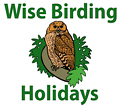
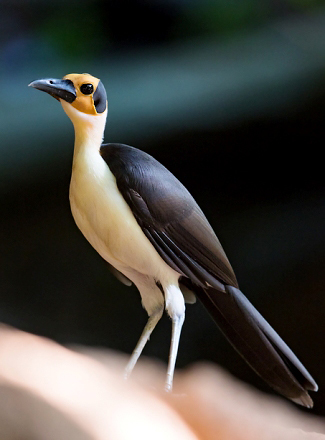
The truly extraordinary White-necked Rockfowl in Ghana by Dubi Shapiro.
- The easiest place in the world to see the extraordinary White-necked Rockfowl or Yellow-headed Picathartes
- And many other West African and Upper Guinea Forest specialities including Blue-moustached Bee-eater, Brown-cheeked Hornbill and Yellow-bearded Greenbul
- As well as more widespread spectacular African species such as Black Heron, Saddle-billed Stork, Egyptian Plover, Chocolate-backed Kingfisher, Rosy Bee-eater, Blue-bellied Roller and Rufous-sided Broadbill
- And animals including African Elephant, Olive Baboon, and Geoffroy’s Colobus, Olive Colobus, Lowe’s, Patas and Lesser Spot-nosed Monkeys
- All in lush rainforests which gradually
merge into dry, open savanna in the north
- White-necked Rockfowl, which is also known as Yellow-headed Picathartes, is not extraordinary just because it plasters a large mud-cup nest to a rock face in the rainforest. It also looks like nothing else one might see in a rainforest. It is a big bird, the size of a feral pigeon, with a long neck, long tail and long, strong legs which it uses to bound across the forest floor, and it also has exquisite silk-like grey and white plumage, all topped off by a bare, bright yellow head. It may be big but it is also secretive and to see a picathartes one must visit a nesting and roosting colony, very few of which are known and even fewer of which are accessible within its limited range from Guinea to Ghana. However, there is a place, in Ghana, where the chances of glimpsing one even seeing one well even photographing one are relatively high. A colony of about 30 pairs nest near the village of Bonkro where, with the guidance of villagers, whom benefit directly from the income provided by visitors, it is possible, with patience, to see what is likely to be the bird-of-the-trip on a trip to Ghana.
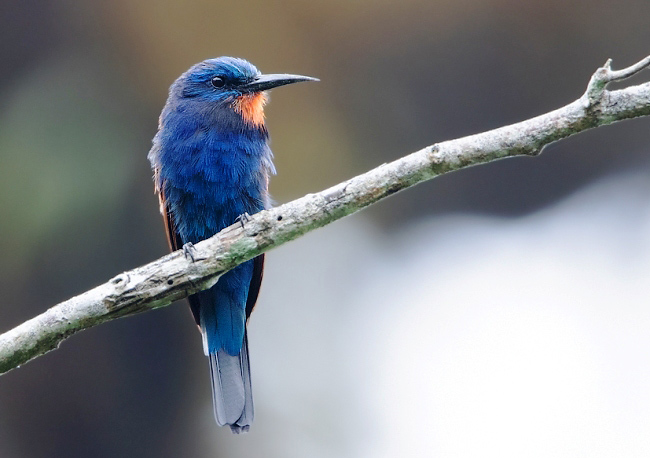
A fine portrait of a Blue-moustached Bee-eater by Dubi Shapiro.
Best Birds and other wildlife in Ghana
Birds
West African endemics
Ghana to Guinea-Bissau 1 Ussher's Flycatcher.
Ghana, Guinea, Sierra Leone, Liberia and Côte d'Ivoire 12 White-breasted Guineafowl (rare and unlikely to be seen), Rufous Fishing-owl (rare and unlikely to be seen), Brown-cheeked Hornbill, Western Wattled Cuckooshrike, White-necked Rockfowl, Black-headed Rufous-warbler, Green-tailed Bristlebill, Yellow-bearded Greenbul, Rufous-winged Illadopsis, Copper-tailed Starling, Nimba Flycatcher (rare and unlikely to be seen) and Red-fronted Antpecker (rare and unlikely to be seen).
(The 14 Upper Guinea Endemic Bird Area (EBA) endemic birds are White-breasted Guineafowl, Rufous Fishing-owl, Brown-cheeked Hornbill, Western Wattled Cuckooshrike, White-necked Rockfowl, Sierra Leone Prinia, Sharpe's Apalis, Black-headed Rufous-warbler, Green-tailed Bristlebill, Yellow-bearded Greenbul, Rufous-winged Illadopsis, Copper-tailed Starling, Nimba Flycatcher and Gola Malimbe. Recent research suggests Liberian (White-winged) Greenbul may merely be an aberrant form of Icterine Greenbul)
Ghana, Guinea, Sierra Leone, Liberia, Côte d'Ivoire and Togo 2 Sharpe's Apalis and Yellow-chinned (Green) Sunbird.
Guinea to Nigeria 4 Melancholy (Gabon) Woodpecker, Fanti (Velvet-mantled) Drongo, Western Bearded Greenbul and Finsch's Flycatcher-thrush.
Guinea to Cameroon 7 Blue-moustached Bee-eater (also Bioko), Fire-bellied Woodpecker, Red-billed Helmetshrike, Red-cheeked Wattle-eye, Kemp's Longbill, Baumann's Greenbul and Buff-throated Sunbird.
Guinea to Cameroon, and Mali 1 Togo Paradise-whydah.
Côte d'Ivoire to Cameroon 1 Black-crowned Capuchin Babbler.
Ghana, Togo, Benin and Nigeria 1 Togo (Yellow-billed) Barbet.
Other Specialities
Egyptian Plover, Chattering Yellowbill, Black and Rosy Bee-eaters, Rufous-sided Broadbill and Fiery-breasted Bushshrike. Also a chance of Brown Nightjar
and an outside chance of White-crested Tiger-heron.
Others
Hamerkop, Black Heron, Saddle-billed Stork, Palm-nut, White-backed and White-headed Vultures, African Cuckoo-hawk, Bateleur, Black Sparrowhawk,
White-spotted Flufftail, African Jacana, Four-banded Sandgrouse, pigeons, doves, Grey, Red-fronted and Senegal Parrots, Green, Violet and Yellow-billed
Turacos, Western Grey Plantain-eater, cuckoos including African Emerald, coucals, Fraser’s and Greyish (Spotted) Eagle-owls, Long-tailed Nightjar,
spinetails, Narina’s Trogon, kingfishers including Blue-breasted, Chocolate-backed and Giant, Red-throated and Swallow-tailed Bee-eaters, Abyssinian,
Blue-bellied,
Blue-throated, Broad-billed and Rufous-crowned Rollers, woodhoopoes, hornbills, barbets, tinkerbirds, Greater Honeyguide, Cassin’s Honeybird, woodpeckers,
Chestnut Wattle-eye, Sulphur-breasted Bushshrike, Yellow-crowned Gonolek, Brubru, African Golden, Black-winged and Western Black-headed Orioles, African
and Red-bellied Paradise-flycatchers, Piapiac, Preuss’s and White-throated Blue Swallows, greenbuls, Oriole Warbler (Moho), Grey Longbill, Black-capped
Apalis, Tit Hylia, Violet-backed Hyliota, Vanga Flycatcher, White-crowned Cliff-chat, White-tailed (Fire-crested) Alethe, White-tailed Ant-thrush, Forest
Robin, starlings, sunbirds, malimbes, weavers, negrofinches, waxbills, Western Bluebill and Exclamatory (Long-tailed) Paradise-whydah.
Also a chance of African Pygmy Goose, Long-tailed Hawk, Congo Serpent-eagle, Crowned and Martial Eagles, Forbes's Plover, Rock Pratincole, Greater Painted-snipe, Black-collared and Red-headed Lovebirds, Yellow-throated Cuckoo, Olive Long-tailed Cuckoo, Pel’s Fishing-owl, Akun and Shelley’s Eagle-owls, Freckled and Standard-winged Nightjars, White-bellied Kingfisher, Abyssinian Ground-hornbill, Yellow-footed Honeyguide, African Piculet, Bioko Batis, Many-coloured Bushshrike, Sabine’s Puffback, Blue Cuckooshrike, Blue-shouldered Robin-chat, Chestnut-bellied Starling, African Spotted Creeper and Black-bellied Seedcracker, and an outside chance of Hartlaub’s Duck, Crested Guineafowl, Spot-breasted Ibis and Nkulengu Rail.
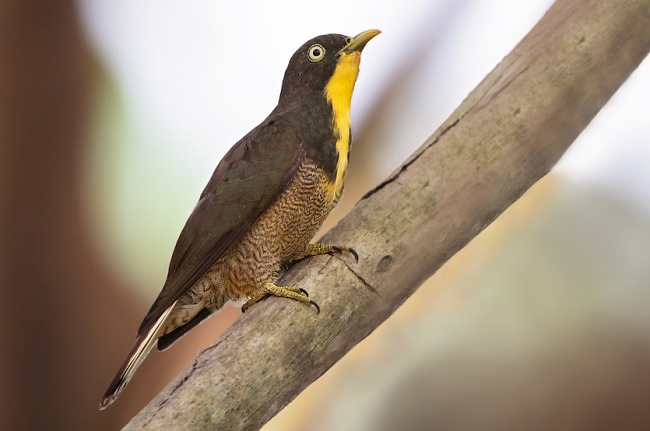
The unusual Yellow-throated Cuckoo, by Dubi Shapiro.
Mammals
African Elephant, Common Bushbuck, Kob, Defassa Waterbuck, Olive Baboon, Warthog, Callithrix, Geoffroy’s Pied and
Olive Colobuses, Lowe’s (Mona), Patas and Lesser Spot-nosed Monkeys, Lord Derby’s and Pel’s Anomalures, Demidoff's Galago and Potto.
Reptiles
Nile Crocodile.
Invertebrates
Some sites support over 500 butterfly species, including Bobiri (500+) and Ankasa (600+), and it is easy to
see a hundred species in a day at some places, including acracas, charaxes, foresters, harlequins, mother-of-pearls and playboys. The peak time for
butterflies is the second half of October.
Best Sites for Birds and other wildlife in Ghana
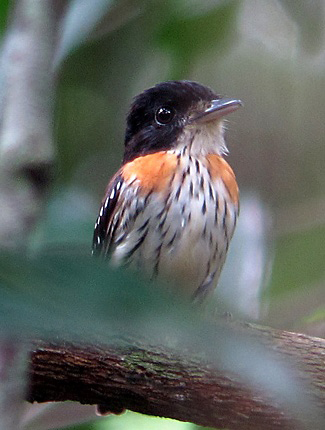
Rufous-sided Broadbill in Ghana by Chris Townend.
- Shai Hills Rosy and Swallow-tailed Bee-eaters, Blue-bellied Roller, Double-toothed Barbet and White-crowned Cliff-chat.
- Sakumono Lagoon, near Accra Black Heron, shorebirds and terns.
- Atewa Range FR Blue-moustached Bee-eater and Green-tailed Bristlebill. Also a chance of Long-tailed Hawk, Crowned Eagle, Yellow-throated Cuckoo, Chocolate-backed Kingfisher, Yellow-footed Honeyguide, Rufous-sided Broadbill, Many-coloured Bushshrike, Baumann’s Greenbul, Black-capped Apalis and Nimba Flycatcher.
- Kalakpa Reserve Black-shouldered Nightjar. Also a chance of Thick-billed and Yellow-throated Cuckoos, Pied-winged Swallow, Red-cheeked Wattle-eye and Blue-shouldered Robin-chat.
- Kakum NP mid-stratum walkway 40 m (120 ft) high, Grey Parrot, cuckoos, Akun and Fraser’s Eagle-owls, Chocolate-backed Kingfisher, Black and Rosy Bee-Eaters, Blue-throated Roller, hornbills including Brown-cheeked, greenbuls, Kemp’s Longbill, Finsch’s Flycatcher-thrush, Forest Robin, Buff-throated Sunbird, Red-vented Malimbe, and Geoffroy’s Pied and Olive Colobuses, Lowe’s (Mona) and Lesser Spot-nosed Monkeys, Pel's Anomalure and Demidoff's Galago. Also a chance of Long-tailed Hawk, Congo Serpent-eagle, White-spotted Flufftail, Rock Pratincole, Black-collared Lovebird, Brown Nightjar, Forest Woodhoopoe, Yellow-footed Honeyguide, Fire-bellied Woodpecker, Rufous-sided Broadbill, Bioko Batis, Blue Cuckooshrike, Sharpe’s Apalis and Potto.
- Offinso Forest A chance of Yellow-casqued Hornbill, Green-tailed Bristlebill and Copper-tailed Starling.
- Nsuta Forest A chance of Long-tailed Hawk, White-spotted Flufftail and Akun Eagle-owl.
- Sekondi A chance of Akun Eagle-owl, and and outside chance of Rufous Fishing-owl.
- Ankasa Forest African Finfoot, kingfishers including White-bellied, Blue-throated Roller, hornbills, greenbuls including Green-tailed Bristlebill and Yellow-bearded Greenbul, Rufous-winged Illadopsis, White-tailed Ant-thrush, Geoffroy's Pied and Olive Colobuses, Lowe's (Mona) and Lesser Spot-nosed Monkeys, Lord Derby's Anomalure, Potto and over 600 butterfly species. Also a chance of Hartlaub’s Duck, Congo Serpent-eagle and Akun Eagle-owl, and an outside chance of Spot-breasted Ibis, Crowned Eagle, Nkulengu Rail, Great Blue Turaco and Red-fronted Antpecker.
- Tonkoase/Bonkro Community Forest White-necked Rockfowl.
- Aboabo Black Bee-eater, hornbills, barbets, Red-billed Helmetshrike and Black-capped Apalis. Also a chance of Long-tailed Hawk, Yellow-throated Cuckoo, Blue Cuckooshrike and Preuss’s Weaver.
- Boberi Forest Narina’s Trogon, Chocolate-backed Kingfisher, Red-billed Dwarf Hornbill, Tit Hylia and over 500 butterfly species. Also a chance of African Cuckoo-hawk, Afep and Western Bronze-naped Pigeons, Brown Nightjar, Forest Woodhoopoe, African Piculet, Blue Cuckooshrike and Preuss's Weaver.
- Opra Forest Blue-moustached Bee-eater, White-crested Hornbill and Fiery-breasted Bushshrike.
- Mole NP African Elephant, Olive Baboon, Patas Monkey, Saddle-billed Stork, Blue-breasted Kingfisher, Red-throated Bee-eater, Abyssinian and Blue-bellied Rollers, Oriole Warbler and Exclamatory Paradise-whydah. Also a chance of Martial Eagle, Forbes’s Plover, Greater Painted-snipe, Pel’s Fishing-owl, Greyish Eagle-owl, Freckled and Standard-winged Nightjars, Northern Carmine Bee-eater, Abyssinian Ground-hornbill, Pied-winged Swallow, African Spotted Creeper and Togo Paradise-whydah.
- Sapleja, White Volta River, near Bolgatanga Egyptian Plover.
- Tongo Hills, near Sapleja Fox Kestrel, Rock-loving Cisticola and Chestnut-breasted Bunting.
Best Times for Birds and other wildlife in Ghana
October-December, especially November, and February to mid-April.
Recommended Bird Books etc. for Ghana
Helm Field Guide: Birds of Ghana by N Borrow and R Demey. Helm, 2010.
Birds of Western Africa by N Borrow and R Demey. Helm, 2014 (Second Edition (paperback)).
Birds of Western Africa by N Borrow and R Demey. Helm, 2002 (First Edition (hardback)).
Birds of Africa south of the Sahara by I Sinclair and P Ryan. C Struik, 2011 (Second Edition).
The Birds of Ghana: An Atlas and Handbook by F Dowsett-Lemaire and R Dowsett. Tauraco Press, 2014.
The Kingdon Field Guide to African Mammals by J Kingdon. Bloomsbury, 2015 (Second Revised Edition).
The Kingdon Pocket Guide to African Mammals by J Kingdon. Bloomsbury, 2016 (Second Edition).
Primates of West Africa by John F Oates. Conservation International, 2011.
Butterflies of West Africa by Torben B Larsen. Apollo Books, 2005.
Apps etc.
The Kingdon Guide to African Mammals.
Where to watch birds in Africa by N Wheatley. Helm, 1995.
Don’t know which country/countries to visit in Africa? Then it may be worth considering taking a look at this book, written by this website’s author. It is many years old of course but it still provides a starting point, an overview and a guiding light to the best birds and the best places to look for them on the continent, and could save hours of searching for similar information on the internet. However, it is important to check more up-to-date sources for sites which have been opened up, sites and species which have been discovered, lodges that have been built etc. since the book was published.
Birding and Wildlife Trip Reports for Ghana
Many trip reports, some for Ghana, are posted on the websites listed here. On some of these websites some reports are independent and some are posted by tour companies who organize tours to Ghana. These tour companies and others also post their own reports on their websites, which are listed under 'Some Organized Tours to Ghana' below.
- The best website for trip reports is CloudBirders
- but these are also worth a look
- Birdtours
- Fatbirder
- Jon Hornbuckle
- Mammal Watching
Local bird and wildlife guides in Ghana
The costs of organized tours partly reflect the quality of the tour leaders. Some leaders are certainly better than others and many companies claim their leaders are the best but even the best rely at least to some extent on the exceptional skills of the local guides they employ. If you are travelling independently, employing such local guides will greatly increase your chances of seeing the wildlife you wish to see.
Accommodation for birders in Ghana
Some Organized Tours for birds and other wildlife to Ghana
There are many tour companies who organize tours to see mammals, birds, other wildlife and other natural wonders. The cost of these tours vary considerably according to such variables as the airlines used, the number of days the tours last, the number of sites visited, the number of people in the group (an important consideration if you wish to see such wildlife as rainforest mammals and birds), the number of tour leaders, the standard of accommodation and transport, and the percentage profit the company hopes to make. Generally, where the number of days tours last and the number of sites visited are similar, the cheapest tours are those that use the cheapest airlines, accommodation and local transport, that have the largest groups with the least number of leaders, and that make the least amount of profit. The most expensive tours tend to be those which are exceptionally long, use the most expensive accommodation (ridiculously lavish in some cases, even for single nights) and which make the most profit. Some tour costs partly reflect the quality of the tour leaders. Some leaders are certainly better than others and many companies claim their leaders are the best but even the best rely at least to some extent on the exceptional skills of the local guides they employ.
While tour companies organize tours with set itineraries many also organize custom tours for individuals and private groups who instead of taking a tour with a set itinerary want to follow their own itinerary to suit their own personal tastes, whether it be mammals, birds, other wildlife, other natural wonders or even man-made attractions, or a mixture of them all. Many organized tours with set itineraries are also fast-paced and target as many species as possible, whether they are mammals, birds or other wildlife or everything, which usually leaves little time to enjoy the best sites and individual species, but on a custom tour those taking part can specify the pace and the sites and species they wish to concentrate on. Custom tours also suit people who like to travel with people they already know, rather than with a group of strangers, and people with partners with different interests. Individuals and small groups will almost certainly have to pay more than the price of an organized tour with a set itinerary but a large group of friends may be able to travel for less than the price quoted for a set tour.
Tour companies who run organized tours or can arrange custom tours to Ghana include the following.
- Birdfinders
- Birdquest
- Field Guides
- Sunbird
- Victor Emanuel Nature Tours
- Wise Birding Holidays
- We are a small wildlife watching holiday company based in Devon (UK) specialising in birdwatching and mammal watching holidays across the world. What sets us apart from other wildlife watching companies is quite simple:
- 1 – small group sizes: (average between 4 – 8 people)
- 2 – a commitment to conservation: (donation after each tour)

